Dominican Spaghetti Recipe That Wins Every Time
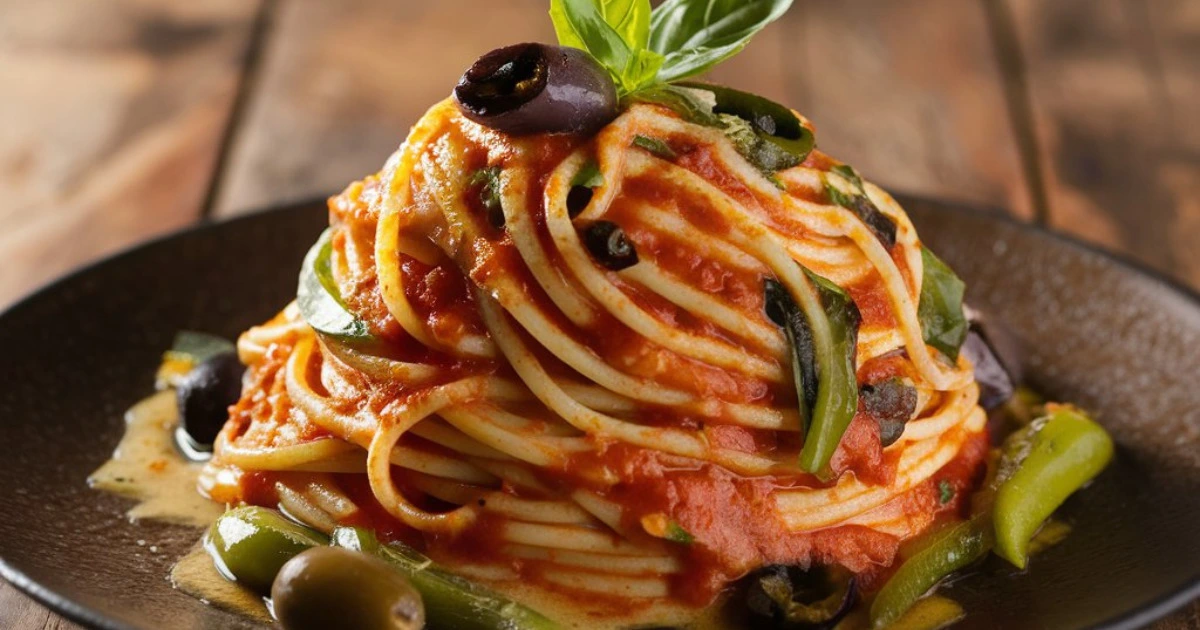
Spaghetti isn’t just Italian—it’s global. And if you’ve never had Dominican Spaghetti, you’re seriously missing out on one of the Caribbean’s most flavorful and comforting pasta dishes. Known as “espaguetis dominicanos” or “spaghetti dominicano”, this hearty dish blends bold seasonings, savory salami, and a creamy tomato base in a way that’ll make you wonder why you’ve been eating plain spaghetti all your life.
Let’s dive into the world of Dominican pasta—where rich traditions, simple ingredients, and comforting flavors come together to create something unforgettable. Trust me, this is the kind of recipe you’ll crave on weeknights, share with your family, and keep coming back to again and again.
Table of Contents
Introduction to Dominican Spaghetti
What Makes Dominican Spaghetti Unique?
Forget al dente. In the Dominican Republic, spaghetti is usually cooked a bit longer, soaking up all the flavorful sauce. This isn’t your minimalist Italian pasta. Dominican Spaghetti is generous, vibrant, and meant to be satisfying. The sauce is thicker, creamier, and has a distinctly seasoned kick—thanks to Caribbean spices, tomato paste, and sometimes even a touch of evaporated milk.
What really sets it apart though? Dominican salami. It brings that smoky, salty depth that no other meat can quite match. Every bite is rich, creamy, and infused with flavor.
You can usually find Dominican salami—brands like Induveca or Campesino—at Latin American markets or online. (Check out this Dominican Salami Recipes guide to explore more traditional ways to use it.)
The Origin of Espaguetis Dominicanos
Like many Dominican dishes, this one has its roots in a blend of cultures—Spanish, African, and indigenous Taino. Spaghetti was introduced during colonization, but it’s the Dominican flair that transformed it into a full-on comfort food. Over the decades, it evolved with local ingredients, adapting to what was accessible and what resonated with local palates.
Why It’s a Beloved Dominican Comfort Food
If you grew up in a Dominican household, you already know—espaguetis dominicanos are a staple at birthday parties, Sunday lunches, and family get-togethers. It’s affordable, easy to make in large batches, and guaranteed to keep everyone full and happy.
It’s also a nostalgic dish. The kind that takes you back to grandma’s kitchen, where the caldero simmered all morning and the smell of sizzling onions and peppers filled the air.
When and How It’s Commonly Served in the Dominican Republic
While you can eat this any day of the week, Dominican Spaghetti is especially popular on the weekends and during holidays. It’s often served with a side of fried plantains (tostones), avocados, or even boiled eggs. Some families like it with a cold glass of fruit juice on the side or a scoop of rice (yes, carbs on carbs—don’t knock it until you try it).
Why You’ll Love This Dominican Spaghetti Recipe
Packed With Caribbean Flavor
We’re talking layers of flavor here—from the aromatic garlic and onions, to the tangy tomato base, and the umami burst from Dominican salami. This isn’t just pasta; it’s an explosion of taste that wakes up your palate.
Simple, Budget-Friendly Ingredients
You won’t need anything fancy or expensive to make this. In fact, most of the ingredients are pantry staples. Tomato paste? Check. Spaghetti? Check. Onions, garlic, peppers? You’ve probably already got those. Even Dominican salami is easy to find at Latin grocery stores or can be swapped for another smoky sausage in a pinch.
Perfect for Family Meals and Gatherings
This is one of those dishes you make when you’re feeding a crowd. Whether it’s a backyard get-together or a weeknight dinner, spaghetti dominicano delivers on both taste and quantity. And because it’s so rich and creamy, a little goes a long way.
Comforting and Nostalgic
Food is emotional, right? And this dish is pure comfort in a bowl. Whether you’re Dominican or just love soulful food, there’s something about this pasta that feels like a warm hug. It’s the kind of meal you want to curl up with after a long day.
Ingredients You’ll Need for Spaghetti Dominicano
Let’s break down everything you’ll need to create this classic Dominican pasta masterpiece.
Traditional Ingredients List
- 1 lb spaghetti (regular or thin)
- 1/2 lb Dominican salami, sliced or cubed
- 1/2 cup tomato paste
- 1/2 cup evaporated milk (optional but recommended for creaminess)
- 1 onion, thinly sliced
- 1 bell pepper (any color), sliced
- 3 garlic cloves, minced
- 1 tsp adobo seasoning
- 1 tsp oregano
- 1/2 tsp sazón (with or without annatto)
- Salt and black pepper to taste
- 2 tbsp olive oil
- 1/4 cup pasta water (to adjust sauce consistency)
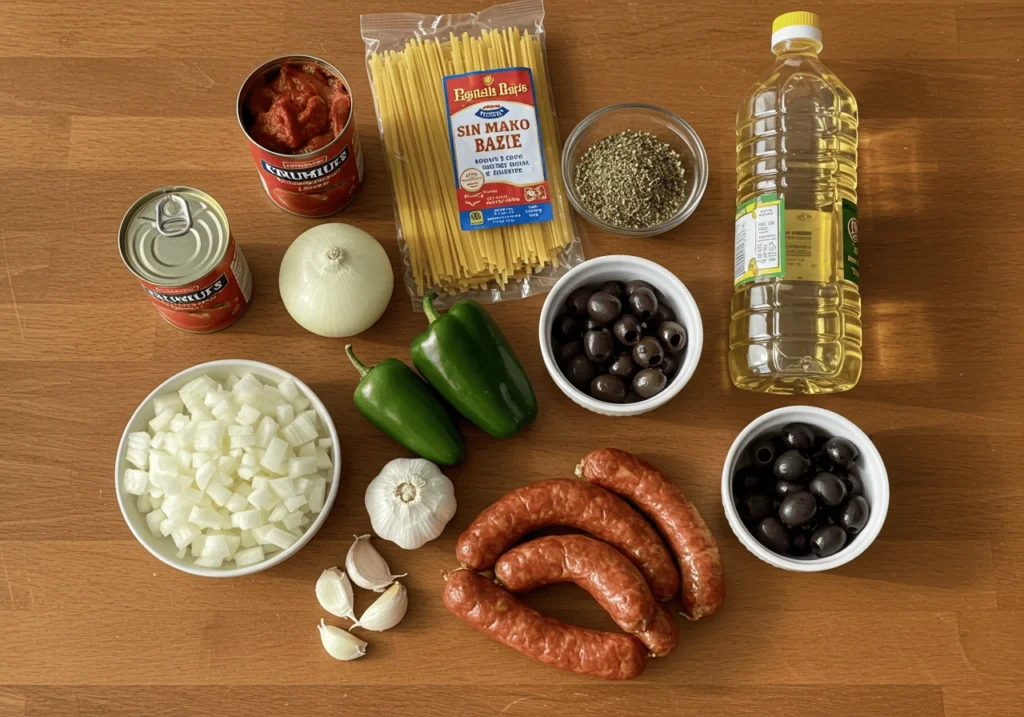
Optional Add-ins for Extra Flavor
- Green olives or capers
- Cilantro or parsley for garnish
- Hot sauce for a spicy kick
- Shredded cheese (some families like to sprinkle a bit on top!)
Where to Find Dominican Salami and Spices
You can usually find Dominican salami—brands like Induveca or Campesino—at Latin American markets or online. The other seasonings like adobo and sazón are now widely available in most grocery stores in the international aisle.
If you can’t find Dominican salami, go for a smoky, thick-cut salami or even a firm turkey sausage. Avoid soft or overly cured types—they won’t hold up in the sauce.
Substitutions for Hard-to-Find Items
No adobo? Use a combo of garlic powder, onion powder, paprika, and salt.
No sazón? Add a pinch of cumin and turmeric for color and flavor.
Evaporated milk can be swapped with heavy cream or omitted for a lighter version.
Kitchen Tools Needed for Dominican Pasta
Caldero or Heavy Pot
The heart of Dominican cooking, the caldero is like a Dutch oven—thick, deep, and perfect for cooking down sauces. If you don’t have one, any heavy-bottomed pot will work.
Pasta Strainer and Stirring Spoon
You’ll need a strainer for draining your spaghetti and a good wooden or silicone spoon to stir the sauce.
Cutting Board and Knife
Prep your onions, peppers, and garlic with a sharp knife to make sure everything cooks evenly and releases maximum flavor.
Measuring Cups and Spoons
Especially useful when working with seasonings like adobo, oregano, and tomato paste. Measuring helps keep that perfect balance of salty, savory, and creamy.
Step-by-Step Instructions to Make Dominican Spaghetti
Step 1 – Cook the Spaghetti
Bring a large pot of salted water to a boil. Add your spaghetti and cook it a minute or two longer than al dente—soft but not mushy. You want it to soak up all the sauce later. Drain it, reserve about 1/4 cup of pasta water, and set aside.
Step 2 – Sauté the Salami
In a caldero or large skillet, heat 2 tablespoons of olive oil over medium heat. Add the sliced Dominican salami and fry until it starts to brown and crisp around the edges. This step adds a delicious caramelized flavor and a bit of chew.
Step 3 – Build the Sofrito Base
Push the salami to one side and add your onions, peppers, and garlic to the same pot. Sauté until everything softens and becomes fragrant. This aromatic blend is the backbone of your sauce.
Step 4 – Add the Tomato Paste and Seasonings
Stir in the tomato paste until it coats the veggies and salami. Sprinkle in the oregano, adobo, sazón, salt, and pepper. Let it cook for a minute or two to eliminate any raw tomato taste. If you like a thinner sauce, add the reserved pasta water now.
Step 5 – Add the Evaporated Milk
Pour in the evaporated milk and stir well. This is what gives the sauce that iconic creamy texture without using heavy cream. Cook for about 2–3 minutes until it all comes together into a thick, luscious sauce.
Step 6 – Toss the Pasta
Add the cooked spaghetti to the sauce and mix everything thoroughly. Let it simmer on low for another 3–5 minutes so the pasta absorbs all that Dominican flavor.
Step 7 – Final Touches
Taste and adjust the seasoning if needed. Add olives or a sprinkle of cheese if you like. Garnish with chopped cilantro or parsley for a fresh pop.
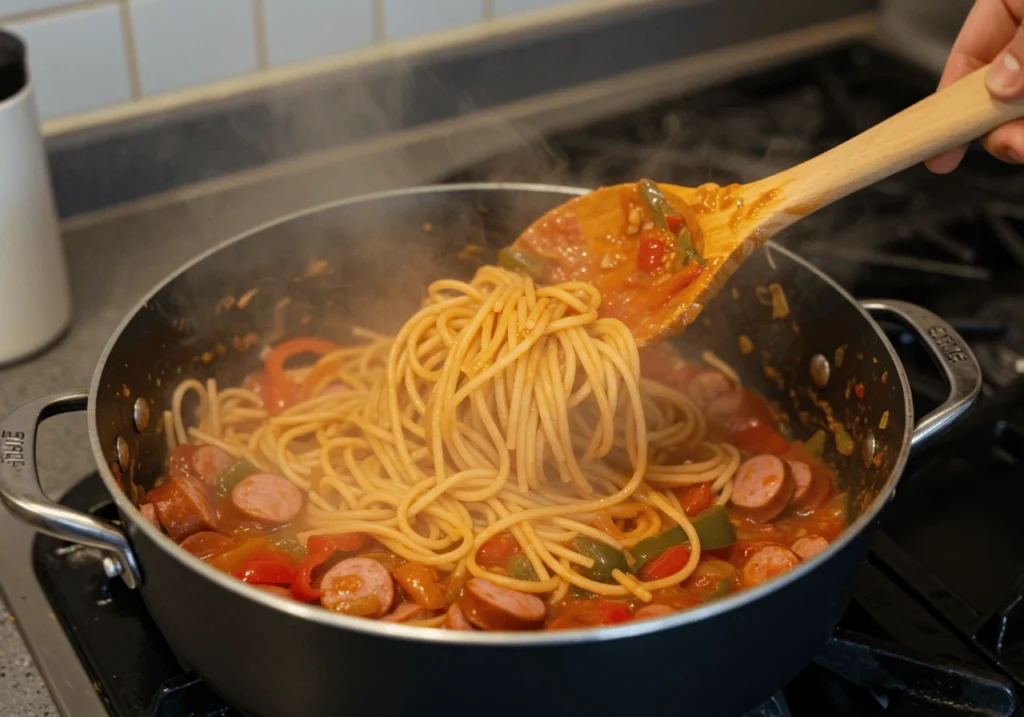
Extra Tips for the Best Dominican Spaghetti
Don’t Skip the Salami Browning
That caramelization builds flavor and gives your sauce that rich base. It’s like the sofrito’s best friend.
Use Pasta Water Wisely
Too thick? A splash of pasta water thins out the sauce while keeping it starchy enough to cling to the noodles.
Let It Sit
After cooking, let the spaghetti rest in the pot with the lid on for 5–10 minutes. The flavors deepen and the sauce soaks into every strand.
Serving Suggestions
Serve Dominican Spaghetti hot and fresh, garnished with chopped parsley or a sprinkle of grated cheese for extra flavor. Pair it with a side of tostones (fried plantains), avocado slices, or a simple green salad to balance the richness of the pasta. For a true Dominican touch, enjoy it with a glass of chilled morir soñando or passion fruit juice!
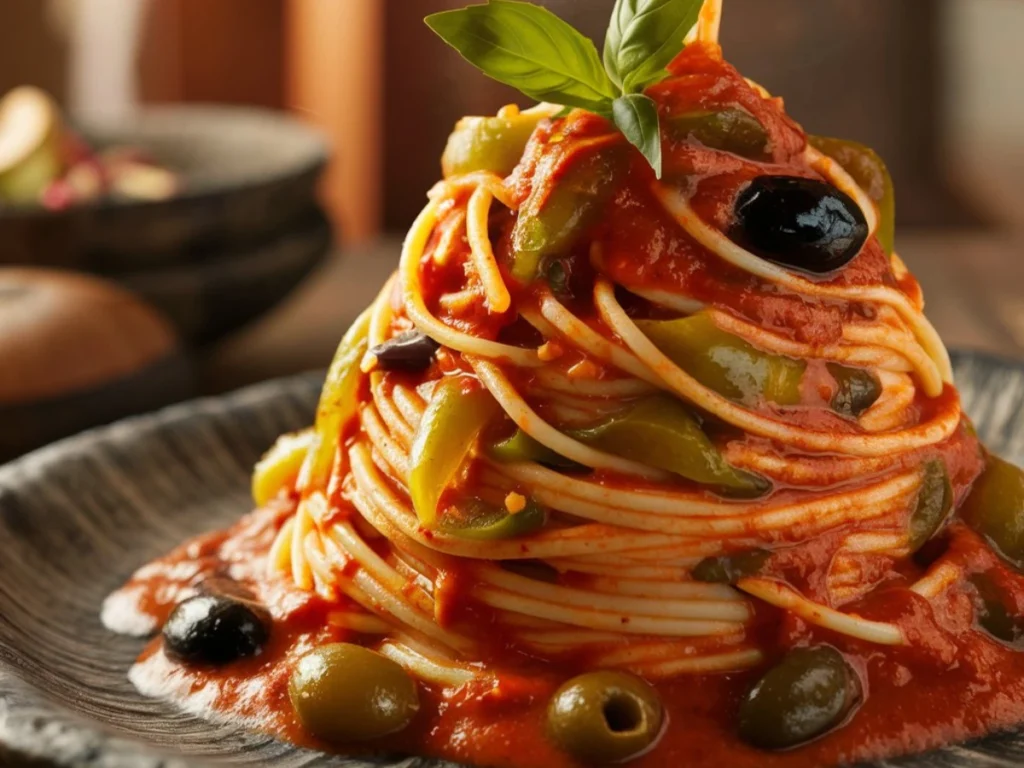
Nutritional Information (Per Serving – Approximate)
- Calories: 400–450
- Protein: 12–15g
- Carbohydrates: 45–55g
- Fat: 18–22g
- Fiber: 3–4g
Note: These values may vary based on ingredient substitutions.
Storage and Reheating Tips
Storage
Place leftovers in an airtight container and refrigerate for up to 4 days.
Reheating
Reheat gently on the stovetop with a splash of milk or water to loosen the sauce. Microwave works too, but stir halfway through.
Freezing
You can freeze it, but the sauce texture may change slightly. Wrap tightly in a freezer-safe container and use within a month.
Ingredient Substitutions
- Dominican salami → smoked turkey sausage, kielbasa, or plant-based sausage
- Tomato paste → tomato sauce (reduce other liquids)
- Evaporated milk → heavy cream, coconut milk (for a dairy-free option)
- Sazón → paprika + cumin + garlic powder mix
More Paste Recipes
- Tini’s Mac and Cheese Recipe
- Marry Me Chicken Pasta Recipe
- Baked Ziti Recipe No Meat
- Ditalini Pasta Recipe
- Chicken Pasta Fazool Recipe
- one-skillet cheesy ground chicken pasta recipe
FAQs About Dominican Spaghetti
Can I make it vegetarian?
Absolutely! Just skip the salami or use a plant-based sausage. You’ll still get great flavor from the spices and vegetables.
Is this dish spicy?
Not usually, but you can add heat with hot sauce or sliced chili peppers if you like it spicy.
What’s the best pasta for this recipe?
Traditional spaghetti works best, but feel free to try linguine or even elbow macaroni for a twist.
Final Thoughts on Dominican Spaghetti
Whether you’re reliving a childhood memory or discovering espaguetis dominicanos for the first time, this recipe brings bold flavors and warm comfort to the table. With pantry staples and easy steps, it’s the perfect way to shake up your pasta night. Try it out, make it your own, and don’t forget to serve it with some crispy tostones or creamy avocado on the side.
Have you tried this Dominican Spaghetti recipe? Share your twist in the comments!
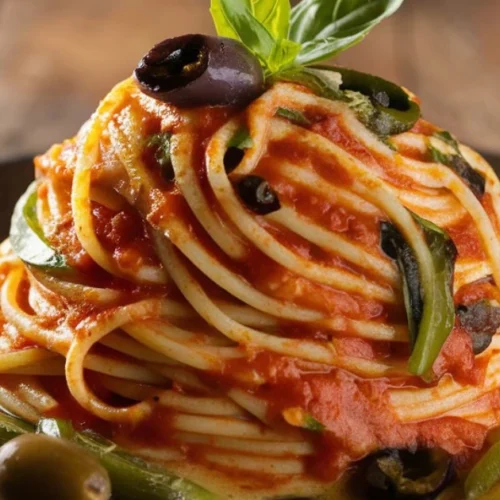
Dominican Spaghetti Recipe That Wins Every Time
Ingredients
Traditional Ingredients List
- 1 lb spaghetti regular or thin
- 1/2 lb Dominican salami sliced or cubed
- 1/2 cup tomato paste
- 1/2 cup evaporated milk optional but recommended for creaminess
- 1 onion thinly sliced
- 1 bell pepper any color, sliced
- 3 garlic cloves minced
- 1 tsp adobo seasoning
- 1 tsp oregano
- 1/2 tsp sazón with or without annatto
- Salt and black pepper to taste
- 2 tbsp olive oil
- 1/4 cup pasta water to adjust sauce consistency
Optional Add-ins for Extra Flavor
- Green olives or capers
- Cilantro or parsley for garnish
- Hot sauce for a spicy kick
- Shredded cheese some families like to sprinkle a bit on top!
Instructions
Step 1 – Cook the Spaghetti
- Bring a large pot of salted water to a boil. Add your spaghetti and cook it a minute or two longer than al dente—soft but not mushy. You want it to soak up all the sauce later. Drain it, reserve about 1/4 cup of pasta water, and set aside.
Step 2 – Sauté the Salami
- In a caldero or large skillet, heat 2 tablespoons of olive oil over medium heat. Add the sliced Dominican salami and fry until it starts to brown and crisp around the edges. This step adds a delicious caramelized flavor and a bit of chew.
Step 3 – Build the Sofrito Base
- Push the salami to one side and add your onions, peppers, and garlic to the same pot. Sauté until everything softens and becomes fragrant. This aromatic blend is the backbone of your sauce.
Step 4 – Add the Tomato Paste and Seasonings
- Stir in the tomato paste until it coats the veggies and salami. Sprinkle in the oregano, adobo, sazón, salt, and pepper. Let it cook for a minute or two to eliminate any raw tomato taste. If you like a thinner sauce, add the reserved pasta water now.
Step 5 – Add the Evaporated Milk
- Pour in the evaporated milk and stir well. This is what gives the sauce that iconic creamy texture without using heavy cream. Cook for about 2–3 minutes until it all comes together into a thick, luscious sauce.
Step 6 – Toss the Pasta
- Add the cooked spaghetti to the sauce and mix everything thoroughly. Let it simmer on low for another 3–5 minutes so the pasta absorbs all that Dominican flavor.
Step 7 – Final Touches
- Taste and adjust the seasoning if needed. Add olives or a sprinkle of cheese if you like. Garnish with chopped cilantro or parsley for a fresh pop.
Notes
Don’t Skip the Salami Browning
That caramelization builds flavor and gives your sauce that rich base. It’s like the sofrito’s best friend.Use Pasta Water Wisely
Too thick? A splash of pasta water thins out the sauce while keeping it starchy enough to cling to the noodles.Let It Sit
After cooking, let the spaghetti rest in the pot with the lid on for 5–10 minutes. The flavors deepen and the sauce soaks into every strand.Review Our Recipe: Your Feedback Makes a Difference
There are no reviews yet. Be the first one to write one.
